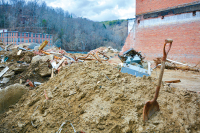Putting the spotlight on Whittier
My Mountain Granny by Matthew Link Baker. Catch the Spirit of Appalachia, Inc., 2010.
In the opening pages of My Mountain Granny, author Matthew Link Baker announces his intention of producing a book that would embody a kind of memorial to the memory of Evelyn Howell Beck, a mountain woman that he encountered in Whittier on Dec. 10, 1998. This meeting was the consequence of Baker’s life long desire to discover the “real Appalachia” and the character of the people who lived there. An associate had assured him that he could learn all he wished to know by talking to Evelyn Howell Beck.
Over a four-year period (1998-2002), Baker would visit Evelyn 20 times. Part of Baker’s book is based on these recorded conversations.
In actual fact, although Baker’s book is a moving tribute to Evelyn, it also qualifies as a homage to the town of Whittier, which once had a “boom town” reputation. The narrative (which manages to be disjointed, pleasant and informative) combines Evelyn’s memories with a collection of remarkable photographs, historical sketches and a generous amount of oral history.
Founded in 1885 by Clarke Whittier, a relative of the poet, John Greenleaf Whittier, this village quickly grew into a robust community that thrived on profits from timber and the commercial advantages of having a newly constructed railroad running through it.
Because the founder’s promotion of the region as a place destined to become “the cynosure of eastern America,” investors and settlers flocked to the new town. (Robert Lee Madison, who would become the founder of Western Carolina University, and his brother Monro were among the first arrivals.) Suddenly, Whittier was filled with excitement, visionaries and hucksters (the most infamous being a fellow named James Latimore Hemrod who fleeced the town and quietly departed). For a short time, sawmills, churches, hotels and boarding houses sprang up like toad stools.
Related Items
Some of the most fascinating information in My Mountain Granny concerns Whittier’s “salad days” — that brief period when the town thrived. Baker gives an entertaining account of the years when Whittier became a center of old camp meetings. Beginning in August, families camped out in and around the town, attending revivals and singings. These events, sometimes called “arbor meetings,” frequently lasted for six weeks. Popular quartets performed and regional ministers preached services that culminated in “alter calls.” Medicine shows, sponsored by major medicine companies, provided hours of entertainments (Bill Monroe and the Grand Old Opry star, Grandpappy) that were interspersed with “doctors” who gave sales pitches for elixirs that cured everything from hair loss to warts and the common cold.
According Baker, Whittier became the Little League baseball center for the region in the 1920s — a title that the town held until the 1970’s. One of the memorable teams was the Whittier Orioles which was composed of Cherokee and white youngsters from the area.
Baker also recounts a famous “Whittier story,” which has become a part of this region’s history/folklore. It concerns Col. Raymond Robbins, a noted public figure in the 1930’s who had become wealthy in the Gold Rush of 1898. Using his money to finance his social work, Robbins became a leading prohibitionist. When the Colonel mysteriously vanished in September 1932, President Hoover, fearing that Robbins had been murdered by political enemies, launched an investigation. Several days later, a man calling himself Reynolds Rogers appeared in Whittier and immediately became an active citizen, attending civic meetings throughout the region, including the Cherokee tribal council.
However, to everyone’s astonishment, a local youth finally recognized him from his photograph in the Grit! Rogers turned out to be the missing Colonel. Did he have amnesia, or did he simply grow weary of his stressful life? (Wilma Ashe, a young Whittier resident, befriended Robbins during his sojourn in Whittier and often told colorful stories about her conversations with him in later years.) After Robbins returned to his estate in south Florida, he often told his friends about the little community that was situated in the fork of two rivers — a place where he had been happy for a short time.
Baker gives a lively account of Whittier during the periods when the town struggled to survive. Especially interesting are the sections that deal with the years when 25 percent of America’s workforce was unemployed. During the 1930s, thanks to Roosevelt’s Work Progress Administration (WPA) and the Civilian Conservation Corp (CCC) with camps at Smokemont — coupled with the community’s reliance home-grown food — Whittier managed well. Evelyn Howell Beck’s memories of those days harkens back to a time when survival required community effort.
“We helped each other,” she said.
The bright economic promise of Whittier was dashed by a combination of unforeseen events: the Great Depression, the creation of the Great Smoky Mountains National Park (which terminated the thriving, but unregulated timber industry), and the devastating flood of 1940. The photographs of this disaster are especially memorable.
Today, Whittier is a quiet village. The railroad, the land speculators and the medicine shows are gone and this little settlement on the Tuckaseigee now attracts people for a different reason. It is, as Clarke Whittier once described it, a kind of pastoral Eden like that perceived by another poet where “peace comes dropping slow.” In the distance, the local residents can hear the thunder of the interstate and the hurry and bustle of progress. However, in Whittier, life has adjusted to a slower pace — there, as in Grey’s famous “Elegy,” the natives treasure the “noiseless tenor of their day.”
In view of this little book’s numerous fine points, it is unfortunate that the text is marred by a number of flaws. For example, the references to Charleston, the old name of Bryson City, are not clarified. The book’s layout is confusing because often, the wonderful photographs and the text are not correlated. Photographs of Robbins are haphazardly placed. Evelyn’s recorded memories are frequently repetitious. Baker occasionally inserts personal observations about the “good old days” that are heartfelt and well-written, but they are not always clearly distinguished from Evelyn’s personal recollections.
All in all, the book’s value as a tribute to a bygone time and the resilience of mountain people certainly outweigh its technical flaws.









